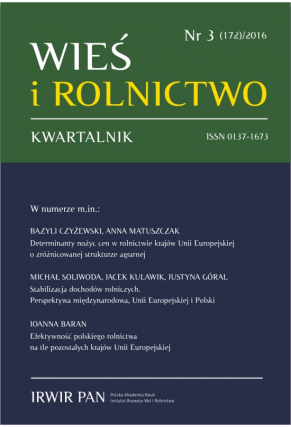How Have the CAP Reforms Contributed to Structural Development in Agriculture?
DOI:
https://doi.org/10.53098/wir032017/02Keywords:
CAP, reform, empirical analysisAbstract
This study aims to analyse the impact of the Common Agricultural Policy and its reforms on the development of agricultural structures. In the analysis we measure the development of rural structures using the number of farms as policy target variable. Our analysis aims to reveal the impact of agricultural policy and policy reforms on the development of the defined target variable, given the general economic and structural development. The analysis is conducted as an econometric panel data analysis. Our results show that agricultural policies have, in general, reduced the pace of structural development and kept more farms in the sector compared to a situation without policies. However, the implementation of CAP reforms in 1992, 2000 and 2007 has led to more rapid structural development. Overall, agricultural policies have smoothened the transition of resources from agriculture to other sectors.References
Ackrill R., Kay A., Morgan W. (2008). The Common Agricultural Policy and its reform: The problem of reconciling budget and trade concerns. Canadian Journal of Agricultural Economics, 56, 393-411. DOI: https://doi.org/10.1111/j.1744-7976.2008.00137.x
Alston J.M., James J.S. (2002). The incidence of agricultural policy. In: B.L. Gardner, G.C. Rausser (eds), Handbook of Agricultural Economics. Vol. 2b: Agricultural and Food Policy (pp. 1689-1749). Amsterdam-London: North Holland Elsevier. DOI: https://doi.org/10.1016/S1574-0072(02)10020-X
Anderson K., Croser J., Sandri D., Valenzuela E. (2010). Agricultural distortion patterns since the 1950s. What needs explaining? In: K. Anderson (ed.). The Political Economy of Agricultural Price Distortions (pp. 25-77). Cambridge: Cambridge University Press. DOI: https://doi.org/10.1017/CBO9780511778964.004
Anderson K., Nelgen S. (2013). Estimates of Distortions to Agricultural Incentives, 1955-2011 (updated June 2013). World Bank. http://econ.worldbank.org/external/ default/main?pagePK=64214825&piPK=64214943&theSitePK=469382&contentMDK=21960058 [accessed: 23.07.2014].
Arovuori K. (2015). The political effectiveness of agricultural policies – an empirical analysis. Academic Dissertation. PTT Publication 23. 124 p.
Arovuori K., Yrjölä T. (2016). The impact of the CAP and its reforms on the productivity growth in agriculture. In: Proceedings of the 147th EAAE Seminar CAP Impact on Economic Growth and Sustainability of Agricultural Areas. Sofia, 14 p. [also available at: http://ageconsearch.umn.edu/bitstream/212241/2/Arovuori.pdf].
Bates R.H., Block S. (2010). Agricultural trade interventions in Africa. In: K. Anderson (ed.). The Political Economy of Agricultural Price Distortions (pp. 304-331). Cambridge: Cambridge University Press. DOI: https://doi.org/10.1017/CBO9780511778964.014
Beck T., Clarke G., Groff A., Keefer P., Walsh P. (2001). New tools in comparative political economy: The database of political institutions. World Bank Economic Review, 15 (1), 165-176. Updated. DOI: https://doi.org/10.1093/wber/15.1.165
Bullock D.S., Salhofer K. (2003). Judging agricultural policies: A survey. Agricultural Economics, 28, 225-243. DOI: https://doi.org/10.1111/j.1574-0862.2003.tb00140.x
Bullock D.S., Salhofer K., Kola J. (1999). The normative analysis of agricultural policies: A general framework and review. Journal of Agricultural Economics, 50 (3), 512-535. DOI: https://doi.org/10.1111/j.1477-9552.1999.tb00896.x
Dutt P., Mitra D. (2010). Impacts of ideology, inequality, lobbying and public finance. In: K. Anderson (ed.). The Political Economy of Agricultural Price Distortions (pp. 278-303). Cambridge: Cambridge University Press. DOI: https://doi.org/10.1017/CBO9780511778964.013
European Economic Community (1957). The Treaty of Rome. http://ec.europa.eu/economy_finance/emu_history/documents/treaties/rometreaty2.pdf. Referred 29.10.2011. 80 p. [accessed: 23.07.2014].
Eurostat (2016). http://epp.eurostat.ec.europa.eu/cache/ITY_SDDS/en/aact_esms.htm [accessed: 20.10.2016].
FAOSTAT (2016). www.fao.org/faostat/en [accessed: 23.09.2016].
Gawande K., Hoekman B. (2010). Why governments tax or subsidize agricultural trade. In: K. Anderson (ed.). The Political Economy of Agricultural Price Distortions (pp. 241-277). Cambridge: Cambridge University Press. DOI: https://doi.org/10.1017/CBO9780511778964.012
Harvey C.R. (2004). Policy dependency and reform: Economic gains versus political pains. Agricultural Economics, 31, 265-275. DOI: https://doi.org/10.1016/j.agecon.2004.09.012
Hughes-Hallet A.J. (1989). Econometrics and theory of economic policy: The Tinbergen-Theil contributions 40 Years on. Oxford Economic Papers, 41, 189-214. DOI: https://doi.org/10.1093/oxfordjournals.oep.a041892
Jensen M.S., Lind K.M., Zobbe H. (2009). Enlargement of the European Union and agricultural policy reform. European Integration, 31 (3), 329-348. DOI: https://doi.org/10.1080/07036330902782170
Olper A. (1998). Political economy determinants of agricultural protection levels in EU member states: An empirical investigation. European Review of Agricultural Economics, 25, 463-487. DOI: https://doi.org/10.1093/erae/25.4.463
Olper A. (2008). Constraints and causes of the 2003 EU agricultural policy reforms. In: J.F.M. Swinnen (ed.). The Perfect Storm. The Political Economy of the Fischler Reforms of the Common Agricultural Policy (pp. 83-101). Brussels: Center for European Policy Studies.
Olper A., Raimondi V. (2010). Constitutional rules and agricultural policy outcomes. In: K. Anderson (ed.). The Political Economy of Agricultural Price Distortions (pp. 358-391). Cambridge: Cambridge University Press. DOI: https://doi.org/10.1017/CBO9780511778964.016
Pokrivcak J., Crombez C., Swinnen J.F.M. (2006). The status quo bias and reform of the Common Agricultural Policy: Impact of voting rules, the European Commission and external changes. European Review of Agricultural Economics, 33 (4), 562-590. DOI: https://doi.org/10.1093/erae/jbl027
Swinnen J. (ed.) (2008). The Perfect Storm. The Political Economy of the Fischler Reforms of the Common Agricultural Policy. Brussels: Center for European Policy Studies.
Thies C.G., Porsche S. (2007). The political economy of agricultural protection. The Journal of Politics, 69, 116-127. DOI: https://doi.org/10.1111/j.1468-2508.2007.00498.x
Tinbergen J. (1952). On the Theory of Economic Policy. Amsterdam: North-Holland.
Tinbergen J. (1967). Economic Policy: Principles and Design. 4th revised printing. Chicago: Rand McNally.
Wooldridge J. M. (2010). Econometric Analysis of Cross Section and Panel Data. 2nd edition. Cambridge, Mass.: The MIT Press.
World Bank. (2016). http://databank.worldbank.org/ [accessed: 9.11.2016].
Zee F.A. van der (1997). Political Economy Models and Agricultural Policy Formation: Empirical Applicability and Relevance for the CAP. Wageningen: Agricultural University.
Downloads
Article file downloads
Pages
How to Cite
Issue
Section
License
Copyright (c) 2017 Wieś i Rolnictwo

This work is licensed under a Creative Commons Attribution 4.0 International License.










